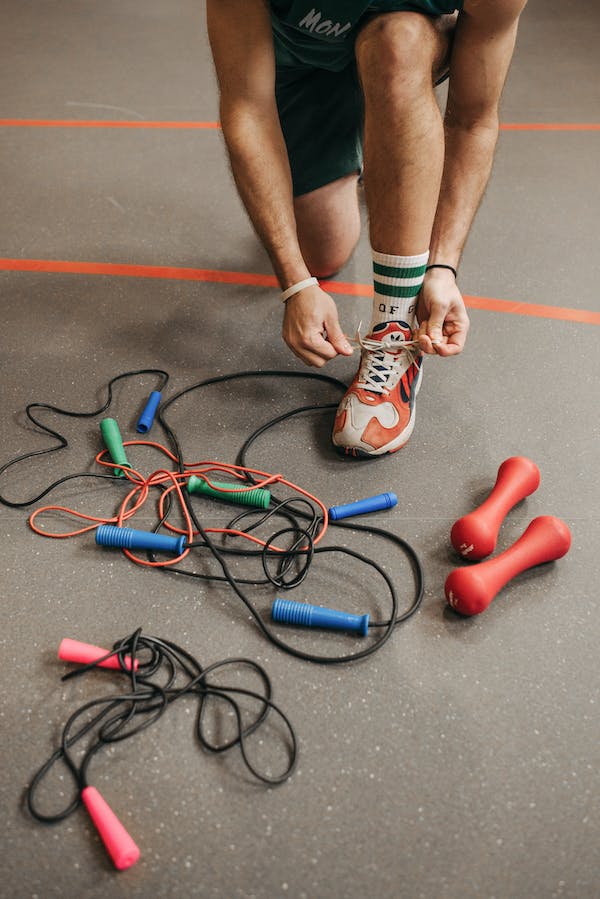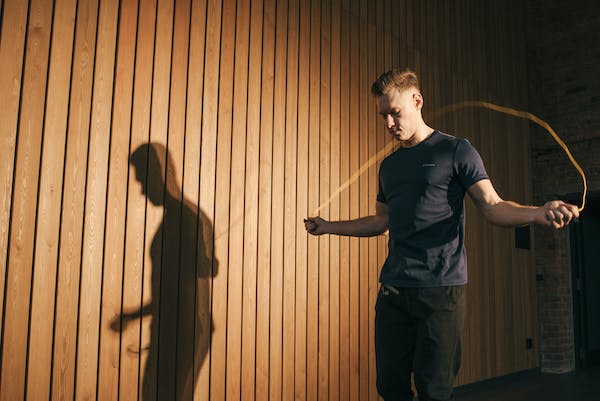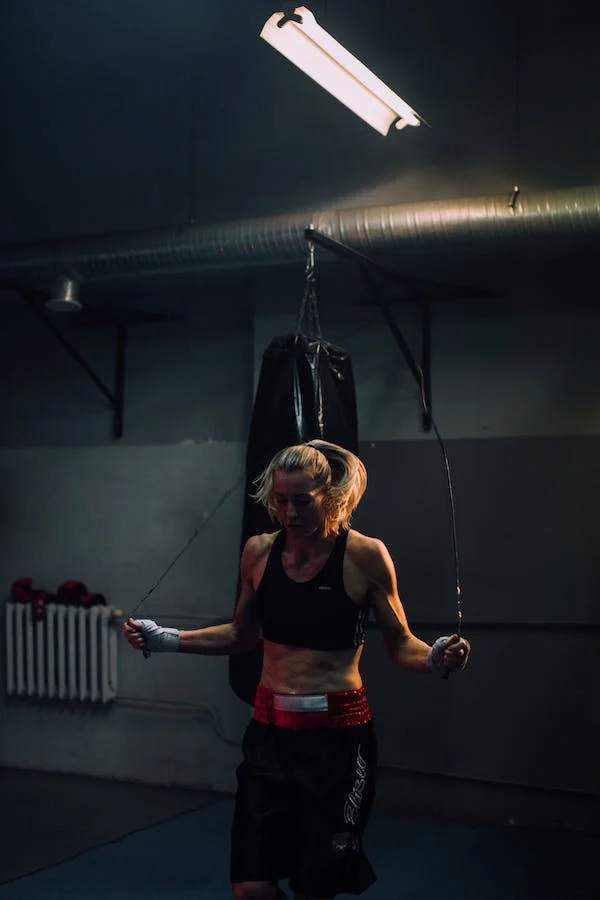WHAT CONSTITUTES A GOOD SKIPPING ROPE?
When it comes to exercise equipment, it’s always a good idea to find the very best equipment available in your price range, and a skipping rope is no exception. In this guide we look through skipping rope specifics and explain what you need to find the right one for you and your activities.
It all really comes down to what you’re using it for. Despite being a fairly simple tool for exercising, there are a wide variety of different types of skipping ropes, so it’s worth thinking about your skill level and what you will be using it for. Looking at the different features of the different skipping ropes, we will start to see what works for you.
Material – When choosing the right skipping rope for you, it’s really important that you check the rope’s material for thickness and density. With rope that is low density and thicker, for example a PVC rope, you will feel the air resistance as the rotation gets faster. However, if the rope is thin and dense, such as steel skipping ropes, there will be a greater speed. For beginners, cloth or PVC skipping ropes are the best to go for.
Weight – This is vital to get right, especially when you are choosing skipping ropes for beginners, and for when you’re looking to get into serious training. For those not hugely experienced at skipping, a rope that is too heavy can cause quite a painful whip if the exercise goes wrong. As the user gets more experienced, they can look to pick up skipping ropes that will have greater weights
Abrasion resistance – You should choose a skipping rope based on where you’ll be using it . Depending on the floor surface, the degree of abrasion resistance will differ. This is especially important when training outside to ensure your skipping rope won’t wear away too quickly due to repeated friction.
Looking at the different features of the different skipping ropes, we will start to see what works for you.
SKIPPING ROPE FEATURES
Cloth Skipping Rope
The most cheap and cheerful of the family, and the cloth skipping rope is perfect for beginners. This is because if the exercise goes wrong, the softness of the material will prevent the skipping user from experiencing any stinging pain. However as the users get comfortable with the practice of skipping, they may want to move up another level.
Material – Typically made out of either cotton, nylon or polyester, and are usually braided to keep them from tangling. Although they do sometimes have plastic or wooden handles, many cloth skipping ropes simply have knots or finger holes on either side.
Weight – Due to their makeup and design, cloth skipping ropes have a built in swing, but should not get heavier as swinging momentum builds.
Abrasion resistance – These are best used indoors, as they do tend to be unbraid if continuously used in outside settings.

Beaded Skipping Rope
Probably both the most fun and budget friendly skipping rope from our selection, these are perfect if you’re using it for recreational purposes, as opposed to workout purposes.
Material – Made up of plastic beads strung alongon a thin piece of cord, which is either vinyl or cloth. These plastic beads are often multicoloured, and can provide a visually grabbing effect
Weight – They can be awkward to use, and like cloth ropes, they do not turn very fast because of their weight distribution.
Abrasion resistance – While these ropes can be fun for limited use and outdoors, they are not recommended for intense skipping. If you are looking for a jump rope for workout purposes, then you should consider a vinly or steel cable option. These are great for outdoors and double dutch beginners.
Speed Ropes
Seen to be the standard for use in Physical Education, these are far better for developing speed, agility, conditioning and coordination. It’s also a great option for a range of different abilities, from beginners who have got used to skipping via the cloth rope, to those who are looking to make it a serious part of their workout routine.
Material – Made of vinyl & licorice, which is also known as PVC. There are many versions that are easily adjustable by simply tying a knot in the rope below the handle and extending it’s length. Due to the thinness of the cord, it is more prone to tangling.
Weight – As it has less air resistance, it is much lighter and faster than a bead rope, and allows for faster jumping roping moves. It’s often used by athletes for training, as it allows the highest number of turns per minute, bringing a much high intensity workout.
Abrasion resistance – While it can be used outside, again it is better for indoor activities as it can quickly wear down when coming into contact with concrete and other tougher terrains.
Leather Skipping Rope
Made famous by boxers and has featured in a fair number of workout montages in sports films. The leather skipping rope is excellent for providing agility, coordination, and for those that do not necessarily want to go quickly, but instead just want a good workout.
Material – Obviously they are made of leather, which is much thicker than other skipping rope materials and therefore usually one of the more expensive skipping ropes on the market. it is less likely to become twisted, although it is made with the same material that is used for whips, which is an important thing to think about when skipping at any great speed!
Weight – They are thick leather and made with weightened handles, so they do tend to be on the heavier side of the skipping rope range.
Abrasion resistance – Leather ropes tend to be more durable than other varieties and can also withstand impact with the ground better and won’t become brittle as sometimes happens with a rubber rope. However, as an organic material, caution should be urged when using them outside, as they can get damaged when being exposed to moisture.
Steel Cable Skipping Rope
Perfect for high intensity workouts, and great for double jumps, it probably won’t surprise you to learn that steep cable skipping ropes are not for beginners. They’re designed primarily for speed skipping, so if you aren’t totally confident at being able to complete at least 25 reps during a skipping exercise, these are maybe one for the future.
Material – Made of very dense, steel cable, these are skipping ropes that can be very painful to use if a mistake is made.
Weight – The two most popular types of steel cable skipping rope is 2.5mm and 4mm. The latter, obviously the thicker of the two is far better for less experienced users as they are able to feel the rope a lot better, whereas the 2.5mm has a real sense of flight to it, meaning it can be hard to get into the rhythm with.
Abrasion resistance – Partly due to the speed they create, it’s a good idea to avoid using these on concrete, as the hard surface can quickly wear away the plastic coating. However they are good to use outdoors genuinely, in parks with any rubber flooring. They’re also good for gyms with parquet flooring.

Weighted Skipping Rope
If you’re looking for a more intense, cardiovascular and calorie burning workout, then this may well be the skipping rope for you. They’re also excellent for developing coordination, muscle and strength.
Material – As it has to carry a greater weight than other ropes, the cable is made from thicker nylon fabric and is more durable.
Weight –The weighted part of the jump rope can be in the handles, or there is the option to hang the weights on the rope itself. The amount varies, but most fall between 0.1 and 0.9 kilograms. Although this may not sound like a great load, the weight does start to add up when you’re jumping for a prolonged period of time.
Abrasion resistance – As the cables themselves have far more durable coatings than others, it is possible to train outdoors with a weighted skipping rope. At the same time however, you are skipping with a heavier rope, meaning there will be a great impact when it does come into contact with surfaces.
WHAT TYPE OF TRAINING IS YOUR SKIPPING ROPE BEING USED FOR?
If you’re just starting out training with your skipping rope and only using it once or twice a week, opt for one with a low to moderate speed.
For more regular training (we’re talking two to four times a week), choose a rope with good rotation (with bearings) for a moderate to rapid speed.
For intense training (more than four times a week) and to add difficulty to your exercises, we suggest choosing a jump rope with weighted handles. This will allow you to do cardio and strength training at the same time.
When thinking about bringing skipping rope to your training, here are few things to remember:
– Skipping for beginners? It’s best to go for a rope for medium to high density, such as PVC or 4 mm steel ropes that are the most suitable for beginners.
– Feel like you want skipping to be your main workout? We would say the best choice would be weighted skipping ropes.
– If you’re using a skipping rope for more functional workouts, a steel cable rope is the one for you, 4mm for beginners and 2.5mm if you have mastered the technique.
– If you’d like to incorporate skipping into your martial arts training, the 4 mm steel or leather ropes are the best to go for.
– If you train outdoors, you can use either weighted jump ropes (with PVC coated cables) or steel cable ropes, preferably 4 mm. Outdoors, in damp conditions, leather or fabric ropes, or wooden handles are not recommended.
– Handles should be comfortable in your hands. When using a skipping rope for working out, go for comfortable lightweight handles, preferably ones that are made of strong durable materials such as metal.
– And if you’re looking to put on a skipping rope show, the only way to go is a colourful beaded skipping rope! These also work well for beginners.



